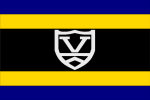Vlasynian Despotate
| Motto: Aeterna Gloria (Latin) "Eternal Glory" | |||||||||||
| Anthem: Despotul (Romanian) "The Despot" | |||||||||||
| File:Vlasynia Map in Europe.png Integral, incorporated provinces are shown in dark green. Unincorporated territories are shown in orange. Autonomous provinces and municipalities are shown in light green. Capital Municipality of Divellis shown in purple, as well as inside the purple circle. | |||||||||||
| Capital | Divellis | ||||||||||
| Largest city | Alexandru I. Cuza (by land area) Divellis (by population) | ||||||||||
| Official languages | Romanian Latin | ||||||||||
| Religion | Orthodox Christianity | ||||||||||
| Demonym(s) | Vlasynian Vlasinian (Romanian) | ||||||||||
| Government | Unitary Despotic monarchy | ||||||||||
• Despot | Ested I | ||||||||||
| Legislature | Despotic Decrees (practical) Consultative Senate of Vlasynia (advisory) | ||||||||||
| Establishment | |||||||||||
• Established as the Empire of Vlasland / Enok | 24 October 2016 | ||||||||||
• Despotate established | 21 December 2017 | ||||||||||
• Became part of Vlasynia-Dartiria | 21 June 2018 | ||||||||||
• Monarchy abolished | 21 July 2018 | ||||||||||
| 23 August 2018 | |||||||||||
• Constitution adopted | 21 February 2021 | ||||||||||
• Disestablished | 01 August 2021 | ||||||||||
| Area | |||||||||||
• Total | 20.74 km2 (8.01 sq mi) | ||||||||||
• Water (%) | 0 | ||||||||||
| Population | |||||||||||
• 2021 census | 10 residents 17 citizens | ||||||||||
| Currency | Vlasynian Leu (VLL) | ||||||||||
| Time zone | UTC+2 (VST) | ||||||||||
| Date format | dd-mm-yyyy | ||||||||||
| Driving side | right | ||||||||||
| Calling code | +40 | ||||||||||
| |||||||||||
Vlasynia (/vləsiːniːə/; Romanian: [vlasi.ni.a]), officially known as the Vlasynian Despotate, was a self-declared de facto independent state with no international/UN recognition (it was de jure considered part of Romania); As such, it was often referred to as a micronation. It was a unitary despotic monarchy, with the Despot holding absolute executive powers. Vlasynia was located entirely in Southeastern Europe. The vast majority of its territories were enclaved within Romania, with 2 exceptions: Horse Island, an unincorporated territory which shared very short river borders with both Moldova and Ukraine on the Danube river, as well as the Musura Territory, which also shared a river border with Ukraine. It had a predominantly temperate-continental climate. The Despotate hosted a total land area of 20.74 square kilometers (8 square miles) and an unevenly-distributed population of 10 people, not including an additional 7 citizens living in Romania, outside Vlasynia's borders. Its capital and largest city population-wise was the Divellis Municipality (shortened as Divellis), and other urban areas included: Chindia, Oltum City, Alexandropol, as well as uninhabited settlements, like Alexandru I. Cuza (which was the largest settlement by land area), Fort Canis and Fort Miro. The entire population identified themselves as Eastern Orthodox Christians and were native speakers of Romanian, a Romance language and one of the two official languages, alongside Latin.
The Despotate was established on 21 December 2017, having been the successor state of the Empire of Enok, a previous micronation established by Ested which had been dissolved exactly six months prior. It began its activity on the Micronations Fandom community, and kept operating there with varying levels of activity until its gradual shift to MicroWiki which was finalized around the years 2019-2020. Outside of the internet, it existed as an independent nation until 21 June 2018, when it united with another Romanian micronation, the Dartirian Empire, to form the State Union of Vlasynia-Dartiria, a federal dual monarchy ruled by two Emperors. One month later, on 21 July 2018, both monarchies were abolished and the previous federal dual monarchy was replaced by a unitary dual presidential republic named the United Republic of Vlasynia-Dartiria. The Vlasynian monarchy, together with the Despotate as an independent nation, were eventually restored on 23 August 2018, following the Vlasyno-Dartirian Crisis and Vlasynia-Dartiria's subsequent collapse. Throughout the next year, the Despotate massively shifted its external policy, entering into a period of expansionism during which it both directly annexed territories and established numerous protectorates throughout Bucharest, which which it even established a personal union. Eventually, on 9 September 2019, through the Realistic Reforms, Vlasynia dissolved all of its protectorates and returned several annexed territories to Romania, in an effort to eliminate all "unrealistic" aspects of the nation which included a claimed population in the thousands, almost all of them being unaware of the Despotate's existence, and territories which it couldn't realistically control. Afterwards, numerous internal changes were made such as, but not limited to: the reorganization of the administrative-territorial system on 29–31 March 2020, the addition of an unicameral parliament, as well as other state institutions on 21 September 2020, and the implementation of the latest constitution on 21 February 2021.
Vlasynia was a founding member and a part of: the Alliance of Romanian Micronations (since 21 March 2018 / 25 June 2020), the Reformed Intermicronational Confederation (since 3 July 2019), the Commonwealth of Vlasynian Nations and Domains (since 10 January 2021) and RAVN (since August 2020). It has also been a member of the North-Western Alliance (since 23 June 2018), the Union of Bucharest Countries (since 23 August 2018) and the Grand Unified Micronational (since 17 June 2020).
The Despotate was in a personal union with the Kingdom of Romania in Sarandë, since Ested I used to rule both nations independently and simultaneously.
The Vlasynian Despotate was officially dissolved on 1 August 2021 and succeeded by the Free City of Vodopol.
Etymology
The name "Vlasynia" is composed of two parts: "Vlas" and "-ynia". The term "Vlasyn" comes from House Vlasyn, of which Ested is a member, while the suffix "-ia" simply means "land". Thus, the country's name translates as "the land of Vlasyn".
When the time came to choose a name right before independence, there were multiple choices for a nation governed by the Vlasyn Dynasty: "Vlasland", "Vlaslandia", "Vlasia", "Vlasistan", as well as others. Out of all the possible options, however, "Vlasynia" was deemed the best, and as such was adopted as the country's name.
Official names
- 21 December 2017 - 21 July 2018: Despotate of Vlasynia
- 21 June 2018 - 21 July 2018: State Union of Vlasynia-Dartiria
- 21 July 2018 - 23 August 2018 - United Republic of Vlasynia-Dartiria
- 23 August 2018 - 07 February 2021: Despotate of Vlasynia
- 21 January 2019 - 20 July 2019: Divellian Union (part of)
- 07 February 2021 - 1 August 2021: Vlasynian Despotate
History
As the Empire of Enok
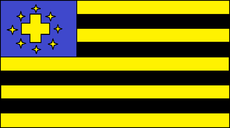
The emblem on the canton became the direct inspiration for Despot Ested's own variation of the Divellion
The first known incarnation of Vlasynia was the Empire of Enok, the first micronation that Ested had ever created. It was established on 24 October 2016, as the "Empire of Vlasland", back when Ested was known as "Mick Vlaas". Vlasland originated as a "bedroom micronation", for all the claimed and controlled territories had been, for months, exclusively part of the Emperor's apartment. This aspect changed on 21 March 2017, in an attempt by Mick to shift the direction of his empire towards actual territorial control, which he achieved on 27 April 2017 when Plumbuita Island (in modern day Plumbuita Province) was annexed and the remained the only physical land under actual control until the end.
Throughout its existence, the empire had changed its name a total of four times: from "Vlasland" to "Ruban" on 2 March 2017, from "Ruban" to "Kamaran" on 21 March 2017, from "Kamaran" to "Kamar" on 22 March 2017, and finally from "Kamar" to "Enok" on 6 May 2017. None of these names, except for "Vlasland", had any specific meaning, and Mick chose them simply because he could. Enok had also changed its flag twice: on 21 March 2017 and once again on 22 March 2017.
During its existence, the empire didn't put any emphasis on foreign affairs, having initiated no diplomatic relations, whatsoever. Instead, Emperor Mick focused solely on nation-building and establishing several territorial claims around the world, in countries such as Romania, Hungary and Egypt, as well as in Antarctica.
On 21 June 2017, between 12:58 and 12:59 UTC+3 (ETC), Emperor Mick officially dissolved the Empire of Enok, declaring: "Due to the lack of support, as well as the wish to properly maintain the other perimeters of life, including school, family, friends, relationships etc, I, Emperor Mick I, officially declare that the Empire of Enok is no more. However, I deeply promise to myself and the world to reestablish the Enokian Empire at some point in the future, when I will be strong, mature and capable enough to maintain proper control over the state and colonies, as well as properly create and maintain diplomatic relations with other micronations and even other legitimate governments. With that being said, Enok out...for now.". After this act, he gave up on micronationalism for the time being.
A period of transition
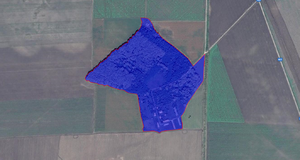
To the very south of said territory lies the village of Alexandru I. Cuza
Sometime in November 2017, several months after his first micronation was disesatblished, Ested discovered the existence of an abandoned village, called Alexandru I. Cuza, located about 30 km east of Bucharest, in the Călărași County, Romania. Once the discovery was made, he immediately declared the desire of owning the village, as well as the territories around it. At the beginning of December 2017, he had the idea of creating another micronation in the area, and as such he started making preparations. On 15 December Ested planned for a suitable day of establishing his new nation. He wanted the national day to be on a special day in December, apart from Christmas Eve, Christmas or New Year, and as such he decided to set it on 21 December, which corresponds to the winter solstice. After all preparations had been made, on the night of 20 December 2017, he wrote the Official Declaration of Independence and the next day he signed it, officially establishing the Despotate of Vlasynia as independent from Romania.
Cuza Period
After achieving de facto independence from Romania, Vlasynia gradually started evolving its diplomatic reputation, as well as its national identity and symbolism.
It adopted a variation of the Divellion (the Despot's personal emblem) as the Coat of Arms and also changed its flag twice: on 8 January and 9 January 2018, respectively. The nation's motto became: "Vivat Magna Vlasinia!", which is the Latin translation of the phrase "Long live Great Vlasynia!", while the new national anthem adopted the same tune as the anthem of the former Kingdom of Romania, albeit without lyrics.
At the same time it initiated diplomatic relations with several micronations from the Micronations Fandom community, including: New Rizalia, Alimia, Egan and Ticronvidia (then known as Titania). Together they put the basis for the League of Micronations and Ested was elected President for a 1 year term, between 8 January 2018 and 8 January 2019. On 21 March 2018 Vlasynia would go on to establish the League of Romanian Micronations, alongside the Republic of Libertia, with Despot Ested I of Vlasynia and President Petru Crăciunoiu of Libertia becoming President and Vice-President of the L.R.M, respectively.
During this period, Vlasynia also expanded its borders in early April 2018 by annexing the Cuzan Parcels, right next to the Mainland, kickstarting Despot Ested' expansionist policy.
First S.W.A.T. Period
On 1 June 2018, Despot Ested, together with HM Lord Gorkin, visited Alexandru I. Cuza and his other claimed territories for the first time. To his disappointment, he found out that a group of people have been legally owning the area for quite some time. As a result, he wouldn't have been able to properly assert his control, and so he left. Later that day he officially abandoned all of his claims over the village of Alexandru I. Cuza and the nearby territories and, as such, Vlasynia was left with no mainland territory or capital. This event started the first S.W.A.T. period ("State Without A Territory") (Romanian: Prima Perioadă de "Stat Fără Teritoriu").
Second S.W.A.T. Period and the Vlasyno-Dartirian Era
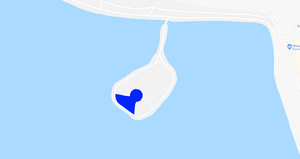
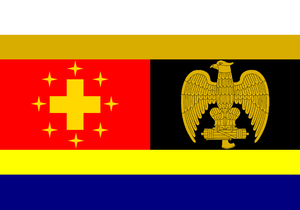

On 21 June 2018, Despot Ested and Co-Emperor Sweyn Hardeknud of another Romanian micronation: the Dartirian Empire, agreed to unite their nations into one, thus the State Union of Vlasynia-Dartiria was born. As a result, Vlasynia became a federal subject of the larger state, with Ested still being Despot of Vlasynia. At the same time, both Ested and Sweyn became the leaders of the Federal Central Government, assuming the title of Emperors. The establishment of Vlasynia-Dartiria also marked the end of the first S.W.A.T. period and the beginning of the second S.W.A.T. period, as Vlasynia itself was still an entity without physical territory at the time.
The second S.W.A.T. period came to an end on 2 July 2018, when Despot Ested went to the Angels' Island/Mill Lake Island (Romanian: Insula Îngerilor/Insula Lacul Morii) and carved up a new power base in the middle of the island, setting his new capital in the settlement of Fort Ested (today known as Fort Canis). Two days later, the Plumbuita Island, which had been in the interest of Ested ever since the days of his first micronation, was also annexed by the Despotate. In the following days, Ested sought to establish diplomatic relations with several other micronations, including more well known ones, such as: the Aerican Empire, Molossia, Sealand and Austenasia.
On 16 July 2018, the two Emperors agreed to abolish their monarchies and establish a republican government, which formally came into effect five days later, on 21 July. Thus, the State Union of Vlasynia-Dartiria became a unitary dual presidential republic known as the "United Republic of Vlasynia-Dartiria". As a result, Vlasynia and Dartiria ceased to exist as separate political entities and their monarchies were also abolished, as both Ested and Sweyn took on the titles of "Presidents". After its establishment, the United Republic sought to expand once more. As such, on 23 July 2018, more territories in what is now the Transteleajen Province were annexed
On 23 August 2018, due to internal disagreements of multiple natures, the leaders of Dartiria (Andrei Rusu and Sweyn Hardeknud) decided to split themselves and their reformed nation (the Revolutionary Republic of Dartiria) from the United Republic, thus ending Vlasynia-Dartiria's two-months-and-two-days existence and restoring the Despotate of Vlasynia as an independent nation.
Protectorate Era

with dark blue and yellow are territories gained during the "September Gains"

On 26 August 2018, Vlasynia occupied and annexed a portion of a town in Romanian Moldavia, establishing the Stefanople Autonomous Commune, which would later become the Stefanople Autonomous Municipality (modern day Alexandropol Autonomous Municipality).
On 30 August 2018, a municipality named Deleni City (which would later become Divellis) was established, centered around Ested's residence. Afterwards, he moved Vlasynia's Capital from Enok City to Deleni City, so he could better administrate his country from home. As a result, Enok City was downgraded to a regular settlement and was renamed to "Fort Canis". At the same time, however, it became the new District Capital of the Bucharest and Ilfov Territories District.
On 1 September 2018, as a result of an agreement between itself and several other Bucharester micronations, Vlasynia gained a large amount of land in Bucharest, with the Lacul Morii, Ghencea and Dobroeşti Provinces becoming part of the Bucharest and Ilfov Territories District (nowadays corresponding with the Moravia and Alexandria-Ghencea Provices, as well as the District of Arteziana in Plumbuita Province and the District of Dobroești Insularis in Dobroești Province). This event was known as "The September Gains". On the same day, the protectorates of Tei and Paque were established.
Afterwards, throughout the next year, Vlasynia kept expanding either directly, by expanding its own territory, or indirectly, by incorporating more and more land into its subject states. During this time, Despot Ested started to make more and more ambitious claims, like areas with hundreds or even thousands of inhabitants, which had no idea of Vlasynia's existence. As a result of these initiatives, the Divellian Union, and later, the Union of Vlasynian States were established on 21 January 2019/100 AGU and 20 July 2019/100 AGU, respectively, in order to extend Vlasynian hegemony as much as possible.
New Despotate Era
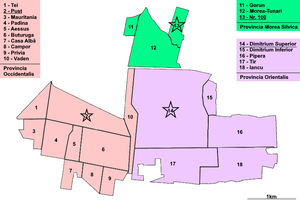
On 9 September 2019/100 AGU, Despot Ested enacted a series of reforms, collectively known as: "The Realistic Reforms" (Romanian: Reformele Realiste), with the intention of realistically organizing Vlasynia's controlled land, population and citizens. The Reforms consisted of the Municipalities of Platan, Bucşeneşti, Vessina, and almost all of Divellis, as well as large portions of the Stefanople and Greenfield Autonomous Municipalities, Chindia City and Oltum City having had their sovereignty officially ceded from Vlasynia to Romania. As a result, Vlasynia lost about 1.76 km2 of land in total and almost all of the 8880 people that had previously been living inside the nation's borders. Despite this, the Reforms were ultimately beneficial and necessary, since none of the 8880 aforementioned residents had citizenship or were even aware of Vlasynia's existence. After the whole ordeal, it was revealed that Vlasynia's actual population was 11 people.
After the Realistic Reforms, Ested overcompensated for his recent territorial losses by annexing uninhabited territories that nowadays belong to the Orientalis, Occidentalis, Morea Silvica, Upper Mogoșoaia, Lower Mogoșoaia, Cuza and Podunavia provinces, which combined make up about 10–11 km2, and at the time made the Despotate more than quadruple in land area.
In the period that followed until the present day, in the era known as the New Despotate, Vlasynia kept focusing on territorial expansion, which lead to the establishment of the Corlovium Military Base on 4 December 2019, as well as the unincorporated territories, starting 19 March 2020. At the same time, several internal changes were also implemented, such as, but not limited to: the retouching of the national flag and the family coat of arms on 9 March 2021, the reorganization of the administrative-territorial system between 29–31 March 2020, which saw the provinces and municipalities becoming the first level administrative subdivisions of the Despotate, the introduction of the Neo-Romanian alphabet on 15 April 2020, the adoption of ensigns for both state use and for the Armed Forces and for the state in May and June 2020, the establishment of an auxiliary legislative body, called the Consultative Senate (Romanian: Senatul Consultativ), a judiciary body called the State Tribunal (Romanian: Tribunalul de Stat), as well as several other state institutions by 21 September 2020, the better grouping of the national subdivisions into regions on 15 January 2021, the adoption of a constitutional document known as the Charter of the Vlasynian State, or State Charter, on 21 February 2021, the establishment of a state-run news agency known as Codrii Vlăsiei News on 22 February 2021, the release of a new series of banknotes for the Vlasynian Leu on 2 April 2021, the publication of the First Amendment to the State Charter on 24 April 2021, etc. Also, in March 2020 and March 2021, HGM Despot Ested I undertook two separate diplomatic initiatives, in which it established formal diplomatic relations and signed Treaties of Support and Cooperation with a multitude of other nations.
Dissolution
On 16 July 2021, HGM Despot Ested I issued an official declaration stating that on 1 August 2021, the Vlasynian Despotate, as well as the Kingdom of Romania in Sarandë and the Commonwealth of Vlasynian Nations and Domains, were all going to be dissolved. The reasons he gave for this drastic action was his lack of interest in leading a micronation all by himself, as well as the need to move onto other aspects of life. On 1 August 2021, this decision formally came into effect, leading to the dissolution of Vlasynia and its replacement by the Free City of Vodopol as its succesor state.
Geography and climate
Climate
Since all of Vlasynia's territories are situated in Romania, this means that both nations have virtually identical climates. As such, the Despotate's climate is temperate and continental, with four distinct seasons, owing to its position on the southeastern portion of the European continent.
| Climate data for the Vlasynian Despotate (territories in and near Bucharest) | |||||||||||||
|---|---|---|---|---|---|---|---|---|---|---|---|---|---|
| Month | Jan | Feb | Mar | Apr | May | Jun | Jul | Aug | Sep | Oct | Nov | Dec | Year |
| Record high °C (°F) | 17.1 (62.8) |
24.1 (75.4) |
29.0 (84.2) |
32.2 (90) |
36.9 (98.4) |
39.0 (102.2) |
42.2 (108) |
41.0 (105.8) |
38.5 (101.3) |
35.2 (95.4) |
25.1 (77.2) |
18.4 (65.1) |
42.2 (108) |
| Average high °C (°F) | 2.8 (37) |
5.5 (41.9) |
11.4 (52.5) |
18.0 (64.4) |
24.0 (75.2) |
27.7 (81.9) |
29.8 (85.6) |
29.8 (85.6) |
24.6 (76.3) |
17.9 (64.2) |
9.8 (49.6) |
3.8 (38.8) |
17.1 (62.8) |
| Average low °C (°F) | -4.8 (23.4) |
-4.0 (24.8) |
0.1 (32.2) |
4.9 (40.8) |
9.6 (49.3) |
13.6 (56.5) |
15.4 (59.7) |
14.9 (58.8) |
10.5 (50.9) |
5.4 (41.7) |
0.6 (33.1) |
-3.4 (25.9) |
5.2 (41.4) |
| Record low °C (°F) | -32.2 (-26) |
-29.0 (-20.2) |
-21.7 (-7.1) |
-9.5 (14.9) |
-1.1 (30) |
4.5 (40.1) |
7.4 (45.3) |
5.2 (41.4) |
-3.1 (26.4) |
-8.0 (17.6) |
-19.4 (-2.9) |
-25.6 (-14.1) |
−32.2 (−26) |
| Average Precipitation mm (inches) | 37 (1.46) |
37 (1.46) |
44 (1.73) |
50 (1.97) |
56 (2.2) |
83 (3.27) |
70 (2.76) |
56 (2.2) |
64 (2.52) |
53 (2.09) |
46 (1.81) |
48 (1.89) |
643 (25.31) |
| Average Snowfall cm (inches) | 13.7 (5.39) |
11.0 (4.33) |
10.5 (4.13) |
1.5 (0.59) |
0.0 (0) |
0.0 (0) |
0.0 (0) |
0.0 (0) |
0.0 (0) |
0.0 (0) |
8.8 (3.46) |
10.5 (4.13) |
56.0 (22.05) |
| Source: Weather Atlas | |||||||||||||
See also
Politics
The Vlasynian Despotate, under the rule of House Vlasyn, is an absolute (despotic) monarchy lead by HGM Despot Ested I. Ever since Vlasynia came into existence, Despot Ested has been enjoying absolute, unrestricted and unquestioned powers over the executive, legislative and judicial branches of state, ruling the country via Despotic Decrees. He also presides over all state institutions such as, but not limited to: the Consultative Senate, the Council of Lords, the State Tribunal, the Armed Forces and its constituent branches, the National Bank, etc.. HGM is simultaneously the Head of State and the Head of Government.
Vlasynia has a unicameral auxiliary legislative body, titled the "Consultative Senate of Vlasynia", consisting of senators, appointed by HGM the Despot , who is also the President of the Senate. The Vice President of the Consultative Senate supervises affairs in the absence or at the behest of the Senatorial President. Each senator has a one-year term, starting on each December 1, while each Senate Session is organized at the request of either the Senatorial President or Vice President. A legislative proposal to which an absolute majority of the senators give their support in an Orientative Vote is going to pass up to HGM the Despot , who then has the final word in regards to the actual promulgation of said proposal.
Foreign relations
Ever since its conception, the Vlasynian Despotate has established diplomatic relations with several nations throughout the world and seeks to maintain friendly relations with as many of them as possible. Diplomatic affairs are managed by HGM the Despot, as Commissar of the Vlasynian Bureau of Foreign Affairs.
Until the second half of the year 2019, Vlasynia's online presence took place entirely within the Micronations Fandom website and community. During this time, it verbally established relations with a multitude of nations also residing in the Fandom community, although none of those "alliances" were made part of a written Treaty. Afterwards, in its pursuit of integrating within the MicroWiki community, Vlasynia relocated its main page and activity to the MicroWiki website and community, where it still remains to this day. This action gave the Despotate the opportunity to reinforce already existing alliances and establish new ones via Treaties of Support and Cooperation.
As such, the first notable diplomatic initiative on MicroWiki started on 31 March 2020, when formal diplomatic relations were initialized with the Directive of Misberia. Treaties were then established with several other nations between late March - early April 2020 and 17 November 2020, ending with the Karno-Ruthenian Empire.
After a halt in micronational activity, the second notable series of diplomatic missions was started on 13 March 2021, when formal relations with the Empire of Imvrassia were initiated. The next day, most Treaties signed until that point were updated by replacing outdated pieces of information with their correct counterparts. At the same time, between 14–15 March 2021, Treaties were established with three Romanian micronations: the Kingdom of Luana, Plushunia and the Snagovian Federal Republic. On 23 May 2021, a Treaty of Support and Cooperation was also signed with the Maritime Republic of The Damariscotta. This diplomatic initiative is expected to continue throughout the following days, weeks, and even months.
The Vlasynian Despotate is a member of the Grand Unified Micronational (since 17 June 2020), the Reformed Intermicronational Confederation (since 3 July 2019), the Alliance of Romanian Micronations, or ALMIRO (since 21 March 2018) and the Commonwealth of Vlasynian Nations and Domains, the latter three of which it is also a founding member.
On 1 August 2021, they all ceased following Vlasynia's dissolution.
Administrative divisions
The Vlasynian Despotate was comprised of multiple territories, almost all of them being enclaves within Romania. The latest administrative-territorial system was established on 29 March 2020, with a major amendment to it published on 31 March 2020.
There were two types of integral administrative-territorial divisions: Provinces and Municipalities, which could have been autonomous or otherwise. Each province was further split into Districts and Settlements.
There were also two further types of subdivisions: Unincorporated Territories and Military Bases. The former were territories under the Despotate's formal administration, which, unlike regular Provinces, were not split into second-level subdivisions, like Districts and Settlements, and had no designated Capital, while the latter were not submitted to the jurisdiction of any existing Province or Municipality and were autonomously governed by the Lord Commanders of the respective branches of the Armed Forces, only answering to the Despot.
There previously used to be another type of administrative-territorial division: the Commune. It was exactly like a Municipality in all aspects but name. The only example of a Commune was the Stefanople Autonomous Commune, established on 26 August 2018. This type of unit, however, ceased to exist when the aforementioned Stefanople Autonomous Commune was reorganized into the Stefanople Autonomous Municipality (nowadays the Alexandropol Autonomous Municipality) on 31 December 2018.
From 15 May 2021 the Vlasynian Despotate was comprised of 17 Provinces, 1 Municipality, 1 Autonomous Province, 2 Autonomous Municipalities, 5 Unincorporated Territories and 1 Military Base.
On 15 January 2021, the Regions of Vlasynia (Romanian: Regiunile Vlasiniei) were established, being defined as "national divisions made of groups of first-level administrative-territorial subdivisions (Provinces, Municipalities, Territories, Military Bases) that are generally located in the same geographic area or share a common geographic characteristic". They had no administrative status, nor did they have any legislative or executive administration, as their purpose was solely to better co-ordinate and organize Vlasynia's territorial divisions. A macronational equivalent to the Regions of Vlasynia were the Development Regions of Romania.
As of 15 May 2021 there were 11 regions:
- Central Region, comprising 1 Municipality, 2 Provinces, 1 Unincorporated Territory and 1 Military Base;
- Northern Region, comprising 3 Provinces;
- Northwestern Region, comprising 2 Provinces;
- Western Region, comprising 3 Provinces;
- Southwestern Region, comprising 1 Province;
- Eastern Region, comprising 2 Provinces and 1 Unincorporated Territory;
- Old Vlasynia Region, comprising 1 Province;
- Prahovan Region, comprising 1 Province and 1 Autonomous Municipality;
- Transdanubian Region, comprising 1 Province and 2 Unincorporated Territories;
- Oltenian Region, comprising 2 Autonomous Provinces and 1 Unincorporated Territory;
- Moldavian Region, comprising 1 Autonomous Municipality;
When compared to the Nomenclature of Territorial Units for Statistics, or NUTS system of the European Union, the subdivisions of Vlasynia would be considered as following:
- NUTS 1 - Vlasynia
- NUTS 2 - Regions
- NUTS 3 - Provinces, Municipalities
- Local administrative units, or LAU - Districts + Settlements/Localities (districte + așezăminte/localități)
| Flag | Name | Type | Local Capital | Region | Size (km2) | Population | Date of foundation | Representative | Map |
|---|---|---|---|---|---|---|---|---|---|
 |
Vodopol | Future Municipality/Future capital city | None (itself) | Undisclosed | Undisclosed | 3 (population to arrive from Divellis) | Not yet founded | HGM Despot Ested I
HM Lord Gorkin Vlasyn |
|
 |
Divellis | Municipality/Capital city | None (itself) | Central Region | 0.0008 | 3 | 30 August 2018 (as Deleni City) 21 January 2019 (renamed to "Divellis") |
HGM Despot Ested I
HM Lord Gorkin Vlasyn |
 |
| N/A | Codru Verde | Province | District of Dimitrium Superior | Northern Region | 5.37 | 0 | 31 March 2020 (as Silva Inferior) 7 April 2020 (renamed to "Orientalis")
|
HGM Despot Ested I | 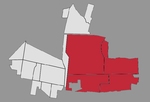 |
| N/A | Codru Alb | Province | District of Pust | Northern Region | 3.56 | 0 | 31 March 2020 (as Silva Superior) 7 April 2020 (renamed to "Occidentalis")
|
HGM Despot Ested I |  |
| N/A | Codru Negru | Province | District No. 100 | Northern Region | 1.13 | 0 | 26 March 2021 (as Morea Silvica) 30 June 2021 (renamed to "Codru Negru") |
HGM Despot Ested I |  |
| N/A | Moravia | Province | Fort Canis | Western Region | 0.733 | 0 | ? ? ? (as Lacul Morii District) ? ? ? (renamed to "Enok") 30 March 2018 (became Province) 15 May 2021 (renamed to "Moravia") |
HGM Despot Ested I | 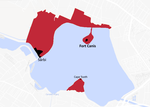 |
| N/A | Giulium | Province | District of Giulești-Sârbi | Western Region | 1.81 | 0 | 29 February 2020 (as Giulești-Sârbi District) 31 March 2020 (became Province) ? ? 2020 (renamed to "Peshmeg") 18 July 2020 (renamed to "Giulium") |
HGM Despot Ested I | |
| N/A | Codru Roșu | Province | District of Codru Roșu | Western Region | 0.241 | 0 | 26 December 2018 (as Dudu District) 31 March 2020 (became Province)
|
HGM Despot Ested I | |
| N/A | Alexandria-Ghencea | Province | District of Ghencea Superior | Southwestern Region | 1.8 | 0 | 1 September 2018 (as District) 31 March 2020 (became Province)
|
HGM Despot Ested I | 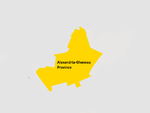 |
| N/A | Bordei | Province | Fort Bordo | Central Region | 0.0417 | 0 | 30 December 2018 (as District) 31 March 2020 (became Province) |
HGM Despot Ested I |  |
| N/A | Plumbuita | Province | Fort Miro | Central Region | 0.0201 | 0 | 4 July 2018 (as District) 31 March 2020 (became Province) |
HGM Despot Ested I | 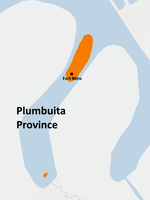 |
| N/A | Dobroești | Province | District of Dobroești Insularis | Eastern Region | 0.158 | 0 | 1 September 2018 (as District) 31 March 2020 (became Province) |
HGM Despot Ested I | 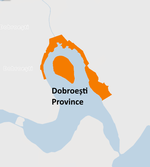 |
| N/A | Upper Mogoșoaia | Province | District of Mogoșoaia Ripensis | Northwestern Region | 0.0369 | 0 | 16 September 2019 (as District) 31 March 2020 (became Province) |
HGM Despot Ested I | 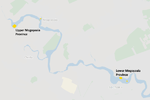 |
| N/A | Lower Mogoșoaia | Province | District of Mogoșoaia-Grivița | Northwestern Region | 0.0203 | 0 | 16 September 2019 (as District) 31 March 2020 (became Province) |
HGM Despot Ested I |  |
| N/A | Cernica | Province | District of Vilarion | Eastern Region | 1.75 | 0 | 7 April 2020 | HGM Despot Ested I |  |
 |
Transteleajen | Province | Fort Ova (De facto)
None (De jure) |
Prahovan Region | 0.24 | 0 | 10 January 2020 (as District) 31 March 2020 (became Province) |
HGM Despot Ested I |  |
 |
Cuza | Province | Alexandru I. Cuza | Old Vlasynia Region | 0.36 | 0 | 16 September 2019 (as District) 31 March 2020 (became Province) |
HGM Despot Ested I | 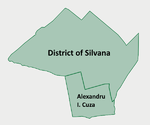 |
 |
Podunavia | Province | Fort Vicina | Transdanubian Region | 1.76 | 0 | 16 September 2019 (as Danubian Autonomous District) 10 January 2020 (Autonomy revoked) 31 March 2020 (Became Province) 15 April 2020 (Renamed to "Poduniavia") |
HGM Despot Ested I |  |
 |
Nova Vlașca | Viceroyalty (Province) | Divellis and Oltum City (de facto administrative centers) | Oltenian Region | 0.0072 | 0 | 30 September 2020 | TM Viceroys Gorkin and Elnik | |
 |
Oltum | Autonomous Province | Oltum City | Oltenian Region | 0.0009 | 3 | 30 September 2020 | Lord Governor Elnik | |
 |
Chindia | Autonomous Municipality | None (Itself) | Prahovan Region | 0.0014 | 3 | 31 December 2018 (as Autonomous District) 10 January 2020 (became Autonomous Municipality) |
Lord Governor Petru | |
 |
Alexandropol | Autonomous Municipality | None (Itself) | Moldavian Region | 0.00082 | 2 | 31 December 2018 | Lord Governor Alexander | |
 |
Corlovium | Military Base under the administration of the Vlasynian Air Forces | None (itself) | Central Region | 0.00208 | 0 | 4 December 2019 (as Corlovy) 29 February 2020 (renamed Corlovium) |
HGM Despot Ested I | 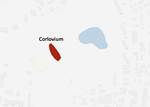 |
| N/A | Horse Island Territory | Unincorporated territory | N/A | Transdanubian Region | 0.77 | 0 | 19 March 2020 | HGM Despot Ested I | 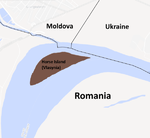 |
| N/A | Tei Lake Territory | Unincorporated territory | N/A | Central Region | 0.00095 | 0 | 19 May 2020 | HGM Despot Ested I | |
| N/A | Musura Territory | Unincorporated territory | N/A | Transdanubian Region | 0.517 | 0 | 25 July 2020 | HGM Despot Ested I |  |
| N/A | Arutela Territory | Unincorporated territory | N/A | Oltenian Region | 0.046 | 0 | 22 December 2020 | HGM Despot [Ested Vlasyn|Ested I]] |  |
| N/A | Calilfia Territory | Unincorporated territory | N/A | Eastern Region | 0.6 | 0 | 15 May 2021 | HGM Despot Ested I |  |
| Flag | Name | Type | Regional Capital | Size (km2) | Population | Date of foundation | Representative | Map | Notes |
|---|---|---|---|---|---|---|---|---|---|
 |
Çankay | Autonomous Beylik (Municipality) | None (Itself) | 0.00075 | 0 | 10 January 2020 - 12 December 2020 | Lord Bey Gorkin Vlasyn | 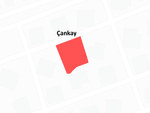 |
Officially abandoned and returned to the Republic of Turkey on 12 December 2020 |
Culture
Vlasynia's culture was largely based on that of Romania, given the fact that almost all of its domains are enclaved within the macronation. However, it had also adopted or self-imposed distinct elements, typical to either Ested or his family as a whole.
National symbols
National and Regional Holidays
Vlasynia's national holidays were defined in Article 3, Paragraph 5 of the State Charter. These were:
| Date | Name of holiday | Description |
|---|---|---|
| 21 February | Constitution Day | The day on which the State Charter was implemented (2021) |
| 9 March | National Flag Day | The day on which the current National Flag of Vlasynia was adopted (2020) |
| 23 August | National Rebirth Day | The day on which Vlasynia regained its independence from Vlasynia-Dartiria (2018);
It is considered to be a second National Independence Day |
| 1 December | Neo-Romanian New Year's Day | The first day of the year in the Neo-Romanian Calendar;
Commemorates the Great Union Day, in which Transylvania de facto united with the rest of the Kingdom of Romania (1918) |
| 21 December | National Independence Day | Commemorates Vlasynia's declaration of indepndence from Romania (2017) |
Other holidays celebrated in Vlasynia and Romania include:
| Date | Name of holiday | Description |
|---|---|---|
| 1 January | New Year's Day | The first day of the year in the Gregorian Calendar |
| Date not constant | Orthodox Easter Day | Commemorates the resurrection of Jesus Christ |
| 1 May | International Workers' Day / Labors's Day | The celebration of laborers and the working classes;
In Romania, it is a free day for employees |
| 1 June | Children's Day | |
| 30 November | Saint Andrew's Day | All people with the name "Andrew" (Romanian: Andrei) and variants of it are celebrated on this day;
In Romania, it is a free day for employees |
| 1 December | Romania's National Day | Commemorates the Great Union Day, in which Transylvania de facto united with the rest of the Kingdom of Romania (1918);
In Romania, it is a free day for employees |
| 25 December | Christmas Day | Commemorates the birth of Jesus Christ |
Media and Entertainment
The media in the country wa managed and checked by the Bureau of Media and Entertainment, which produces, distributes and promotes certain pieces of media, as well as the Bureau of Censorship, which enforces the state-issued bans on media.
Banned media

The Bureau of Censorship used to enforce bans on the following songs, which were imposed by Despotic Decree 1015040, on 4 April 2020:
- Tones and I - Dance Monkey;
- Clean Bandit ft. Demi Lovato - Solo;
- Let me down slowly - Alec Benjamin (revoked a day later);
- The Chainsmokers ft. Daya - Don't Let Me Down;
- Duke Dumont - Ocean Drive;
- Delia - 1234;
- Any song by Cardi B; In the case of the songs that feature Cardi B and another artist, (for example, Girls like you by Maroon 5 ft. Cardi B), the parts featuring Cardi are cut, and only the end result is allowed to be played.
Despotic Decree 1015050, which was enacted on 5 April 2020, revoked the ban on Let me down slowly by Alec Benjamin that was stablished a day prior, while also enforcing a ban on Kisses back by Matthew Koma.
News
Codrii Vlăsiei News is the state-owned and state-run news agency of the Despotate. It has its own section within Vlasynia's official website, hosted on Wordpress and publishes news of national interest regarding the state, House Vlasyn, or both.
Forms of entertainment

About 70% of the population and 56.25% of all citizens know how to play it
One form of entertainment in Vlasynia consists of several TV shows that are also broadcast in Romania. The most popular, sorted by TV channel, are:
- By Pro TV:
- Românii au talent (English: Romanians got talent);
- Vocea României (English: The Voice of Romania);
- Las Fierbinți;
- Vlad (or VLAD);
- Imperiul Leilor (English: Empire of Lions).
- By Antena 1:
- Te cunosc de undeva! (English: I know you from somewhere!);
- Chefi la cuțite.
Another form of entertainment in the Despotate consists of board games, which are especially popular with the Vlasyns, in both Divellis and Oltum City. The most popular and played ones are:
- Catan;
- Camel Up;
- Rezistența (English translation: The Resistance);
- Ticket to Ride: Europe.
Cuisine


Vlasynian cuisine involves several dishes that are being prepared and widely appreciated by members of House Vlasyn. Some of them include:
- Pachețele (English: Packets) - Tortilla wraps containing pressed cheese and other ingredients on the inside, usually grilled with a sandwich maker;
- Vlasynian garlic bread (also known as Vlasynian garlic toast) - Hot toast rubbed with garlic;
- Căpșuni în cană (English: Mug strawberries) - The traditional Vlasynian dessert; Strawberries that are mashed in a mug using a fork and then drunk whole.
External links
- Official website (defunct)
- Official Discord Server (defunct)
- Official YouTube channel
Abbreviations and other terms
VST = Vlasynian Standard Time
A.G.U = After the Great Union. It refers to the years being measured according to the Neo-Romanian Calendar (used only in Vlasynia) around the epoch of said calendar (the Great Union Day of 1 December 1918: Great Union Day)
References
